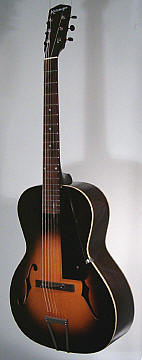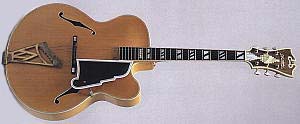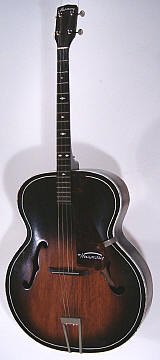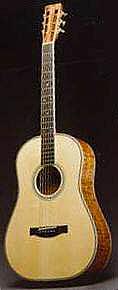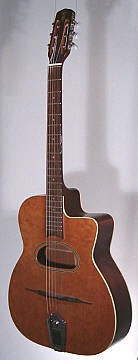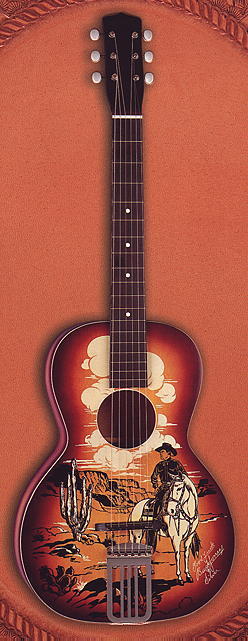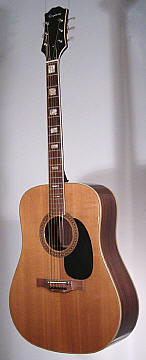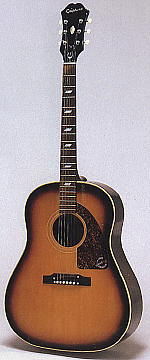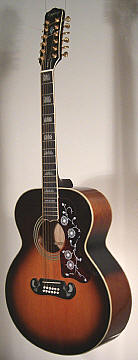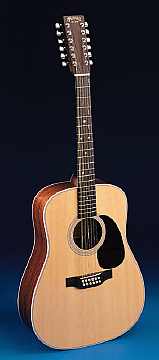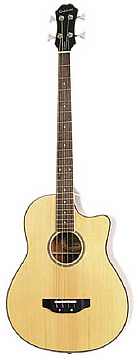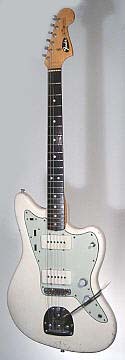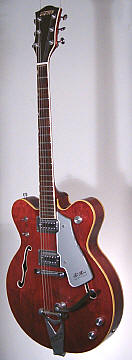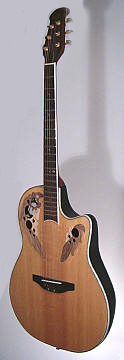| guitars modern | ATLAS of Plucked Instruments |
| •
HOME • about • collection • books • index • links • lutes • guitars early • guitars modern • mandolins • cittern • banjos • steelguitars • miscellaneous • Europe West • Europe East • Europe South • Africa • Middle East • Central Asia • India • Far East • S.E. Asia • America N • America C • America S
|
guitars -
modern (after 1900)
On this second page of the guitars you will find more recent (20th century) instruments (both acoustic and electric) which I regard as "different types", although I realise the choice is quite arbitrair. For resophonic guitars see under steelguitars. For more obscure guitars try also miscellaneous. The older historic instruments, starting with the renaissance period (1500) till about 1900, are shown on the page of guitars early. For early medieval plucked instruments see also under lutes, mandolins and cittern (citole and gittern). |
| top | acoustic guitars | |||||||||||
|
acoustic
archtop guitar In the 1920's Orville Gibson in USA
experimented with building guitars based on the principle of
violin construction, with the front and back carved from a thick plank
in an arched shape. These instruments became quite popular and known
as "archtop guitars" (as opposed to the normal "flat
top guitars"). Many different models were made, later also by other
factories. The archtops became very popular with jazz players, who also wanted more volume to be able to play (audible) solos in the dance and jazz orchestras. This resulted in models being made with ever larger body sizes. These guitars (although now often with a pick-up) are still made, and mainly used in jazz music.
|
|||||||||||
| top | ||||||||||||
|
tenor
guitar The tenor guitar is not what you might expect : a larger guitar (like you have a tenor ukulele, which is larger than the (soprano) ukulele), but it is a kind of (jazz-)guitar with 4 steel strings. In the early 1920's the banjo was the main plucked
instrument played in (jazz) orchestras. The players were often originally
mandolin players, so to use the same fingering for their chords,
they had tuned their banjo (4-string tenor banjo)
in a similar tuning, like : c g d' a'. Tenor guitars were made like the normal (jazz-type) guitars of that period (both archtop and flattop), maybe slightly smaller. The neck was of course a bit narrower, for just the 4 strings. Tuning of the 4 metal strings would be : c g d' a'.
Lots of information can be found on Tenorguitar. |
|||||||||||
| top | ||||||||||||
|
baritone
guitar A baritone guitar is a guitar (of any type or model) that is made with a longer neck. In fact this instrument is part of the large guitar family, with sizes like : soprano, quint, quart, requinto, terz, prime and baritone (see a clear picture of the entire guitar-family : Hago). So the baritone guitar is a kind of bass guitar, with a lower tuning and a longer neck for a longer string-length. Most baritone guitars are steel-strung (heavy gauge) and electric, but in fact all models of guitar could be made like a baritone guitar, and indeed many factories provide them. String-length would be something between 680 and 760mm (normal guitar is around 650mm). The tuning of the baritone guitar is not really
fixed (there are still only a few specialist players), but one could be
: Note that in Argentina a (classical) guitar is tuned to this last tuning, and called a guitarron (see AmericaSouth).
|
|||||||||||
| top | ||||||||||||
|
gypsy
guitar In the 1930 the French instrument factory Selmer (known for brass instruments) hired the (classical) guitarplayer Maccaferri to help design some guitars. The most succesful was this type of guitar, the Jazz model, that was soon used by the famous gypsy guitarist Django Reinhardt. Irony is that both men never met. The instrument is known by names like gypsy guitar, manouch guitar, Django guitar, Maccaferri guitar, Selmer guitar, etc. The guitar is quite large, with a slightly rounded
top (and back). The tuning head and the fingerboard are similar to a
classical guitar. The body had a cut-away to ease playing notes
high on the fretboard. The soundhole is either a large wide D-shape,
or a small oval shape. This guitar is mainly used for "Hot-Club-de-France" jazz, with besides the solo guitar (and sometimes a violin or clarinet) some guitars playing (on identical guitars) strict rhythm and a stringbass. The sound of this guitar type can be easily recognized. Originally the design was a double guitar : there was a second soundbox inside the body. This design was soon dropped, because players did not like it. For much information about the Selmer guitars see Lutherie.net. |
|||||||||||
| top | ||||||||||||
|
cowboy
guitar In the 1930s many western movies with "singing cowboys" inspired quite a few people to also start singing along with a guitar. The guitar in those days was still less popular than mandolins and banjos. Many guitar factories obliged and produced
an inexpensive type of guitar, often in a bit smaller size
than the normal guitars. For some reason these cheaply made guitars
are now quite collectable. For more information see CowboyGuitars. |
|||||||||||
| top | ||||||||||||
|
dreadnought
guitar / jumbo
This large guitar was designed around 1930 in the USA by C.F.Martin as a flat-top wide-bodied guitar, and called (for some reason) after the largest battle ship Dreadnought (D for short). In a similar style it became also known as a Jumbo - after the largest elephant in circus Ringling. This large body-shape was a huge success and it is now the most used guitar type for acoustic guitars. This guitar has always steel strings. The neck is usually quite thin. As it is mainly used to play acoustic music, it is also known as a "western guitar" and as a "folk guitar". The number that usually follows the D (like D28 or D42) is meant to describe the style of decorations (binding, fretboard inlay, etc). |
|||||||||||
| top | ||||||||||||
|
southern
jumbo guitar To counter the competition from the Martin flat-top Jumbo, the Gibson factory introduced in the 1940s a different version of the flattop Jumbo, which they called "Southern Jumbo", or the "Round-shouldered dreadnought". Basically about the same size as the Martin Jumbo, the difference is mainly visible in the sloping shoulders : the rounded top of the body, compared with the almost horizontal top of the Jumbo.
|
|
super
jumbo guitar To counter the success of the Martin Jumbo guitar, Gibson designed (after 1935) an even larger acoustic flat-top steel-string guitar : the SJ-200 model. This one became known as the "Super Jumbo". It has much more decoration than the usually quite plain Martin guitars : like here a decorated pickguard, crown-like fret markers and a bridge with a kind of moustache (or cow horns) on both sides.
The example is a 12-string version. |
||||||
| top | |||||||
|
12 string
guitar As lots of instruments (like mandolins, bandurrias, etc.) have double strings, so of course also the guitar comes in a version with two strings per course. This is only done with metal strings, never with nylon strings - although the old lutes and baroque guitars had double strings which were made of gut (the for-runner of nylon). The courses are not just two strings in unison - only
the two highest ones. The four lower courses are in octaves, with the
higher octave string being on the low side of the course. The guitar can be any normal guitar-shape (either acoustic or electric) and indeed most factories can provide any model in a 12-string version. The 12 string guitar is mainly used for strumming (rhythm guitar) and only rarely for solos (although it gives quite a pleasing sound, especially with the octave strings). See for some history of the 12-string : Frets.com. |
||||||
| top | |||||||
|
acoustic
bass guitar Under the spirit of "unplugged" in the 1990's many bands starting playing "acoustic". This resulted in a need for a range of acoustic bass guitars. So all kind of (acoustic) guitars were made with a long (strong) neck and thick strings to play the bass. Although any body shape could be used, you will rarely find a Jumbo, Super Jumbo or gypsy guitar body shape. Although called "acoustic" nowadays, the bridge is usually fitted with a piezo pickup, so the instrument can be easily amplified. The 4 bass strings are an octave lower than the 4 lowest strings of a normal guitar. Nowadays you may also see 5 string bass guitars, with the extra string tuned to B.
|
| top | electric guitars | ||||||||||||||||
|
solid-body
electric guitar In the 1950's both Leo Fender and Les Paul experimented with making a guitar with a solid body and some electric pick-up to amplify the sound of the vibrating (steel) strings. Fender's Broadcaster (later renamed Telecaster) was the first mass produced solid-body electric guitar. Basically any piece of material can be used for the body, but usually wood is used. Any shape that feels comfortable (or has enough visual impact...) can be used. The shapes of the first models soon became industry standards. As there is more solid material to fix something in than on a delicate normal guitar body, the neck is often bolted on to the body. Two ways of amplification can be used : the single-coil pick-up and the humbucker (two-coils to prevent "hum"). Usually there is a switch for volume and one for treble/bass. With multiple pick-ups you often can switch to using front, back or both pick-ups. Some models have a small arm fixed to the bridge (a tremelo, or"whammy-bar") which can be used for relaxing the strings, making the sound "flowing", "nervously vibrato" or nowadays even "bomb-diving". A popular maker of a tremelo device (that also makes the strings return in tune again...) is Bigsby.
|
||||||||||||||||
| top | |||||||||||||||||
|
electric
bass guitar With the success of the electric solid-body guitar, Leo Fender soon designed an electric bass guitar (the Precision Bass), based on the same principle. It used only the 4 lower strings of the guitar, and with much thicker strings (tuned an octave lower) and a longer string-length (and therefor a stronger neck), it gave an impressive strong bass sound. Soon bass players, who untill then had to carry around a big string bass and had increasingly trouble to be heard with many loud instruments around them, changed over to this instrument, which was much easier to transport and proved also much easier to play. Usually the bass guitar has frets, but many models are available in fretless versions. Soon other makers followed, usually also with solid-body models. Not always, like Paul McCartney's Höfners violin bass guitar. The scale for the Precision Bass was designed by Fender to be 34 inches, or 86cm. It still is the most used length for bass guitars. However many bass guitars use the normal scale length for guitar. Nowadays many bass guitars have 5, 6 or even
7 strings. The 6-string is often in a baritone guitar tuning.
The extra (5th or 7th) string is usually the lowest string tuned to
B.
|
||||||||||||||||
| top | |||||||||||||||||
|
semi-acoustic guitar Not all electric guitars were made of solid wood, many were made in the traditional way, and called semi-acoustic guitars or hollow-bodied guitars. The style followed usually the archtop (or f-hole) models, not the flat tops. The body could be as deep as a normal acoustic guitar; this type was often prefered by players of jazz. The thin version was popular by players of blues. To make it easier to reach the higher frets, the right top half of the body was often with a cut-out. And although not necessary for playing, but just for visual balance, often also the left side got a cut-out. Fender never had a succesfull semi-acoustic guitar; popular factories were Gibson, Rickenbacker and Gretch - with their range of "Country Gentlemen" guitars, designed by Chet Atkins. |
||||||||||||||||
| top | |||||||||||||||||
|
ovation
guitar In the 1960's helicopter designer Kaman produced a very innovative guitar, based on modern materials. The body was based on the 17th century chitarra battente guitars, with a rounded back; only now it was made from special fiberglass. The neck and pegbox was made from plastics. The first models had the front still made of pine wood, and the overall view was quite traditional, with a round sound hole. Later models (like the Adamas) had the front made with thin layers of carbon graphite fibers. The single sound hole was replaced by many round soundholes of different sizes on both sides of the neck, surrounded by thin layers of light wood. Another innovative feature was the use of a special piezo pick-up, built under the saddle of the bridge, which resulted in making the acoustic guitar still sound like an acoustic guitar, even when amplified. It was not even neccesary to use metal strings, the pick-up worked just as good for nylon strings. For more about the Ovation guitars see Ovation. |
||||||||||||||||
|
